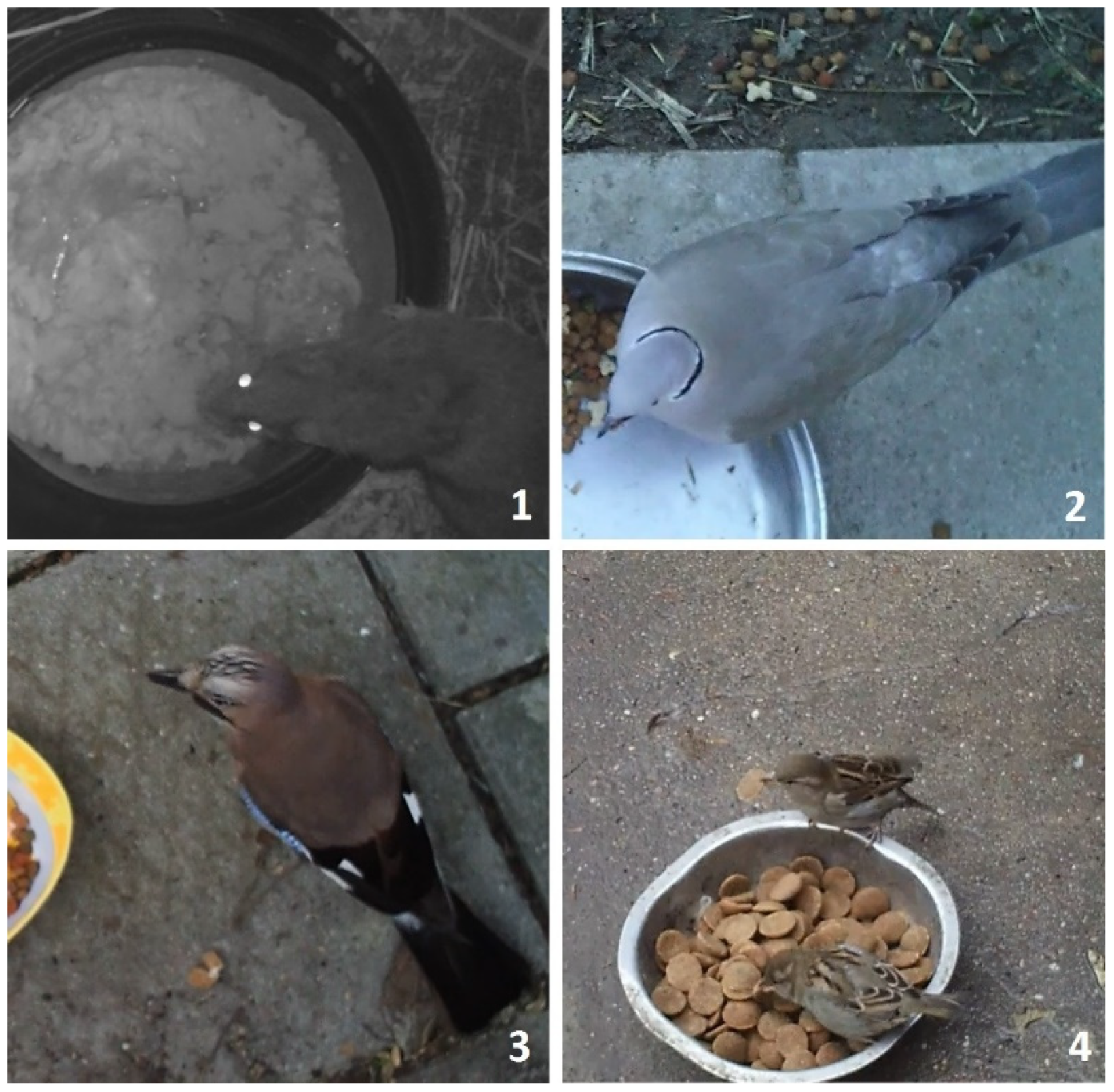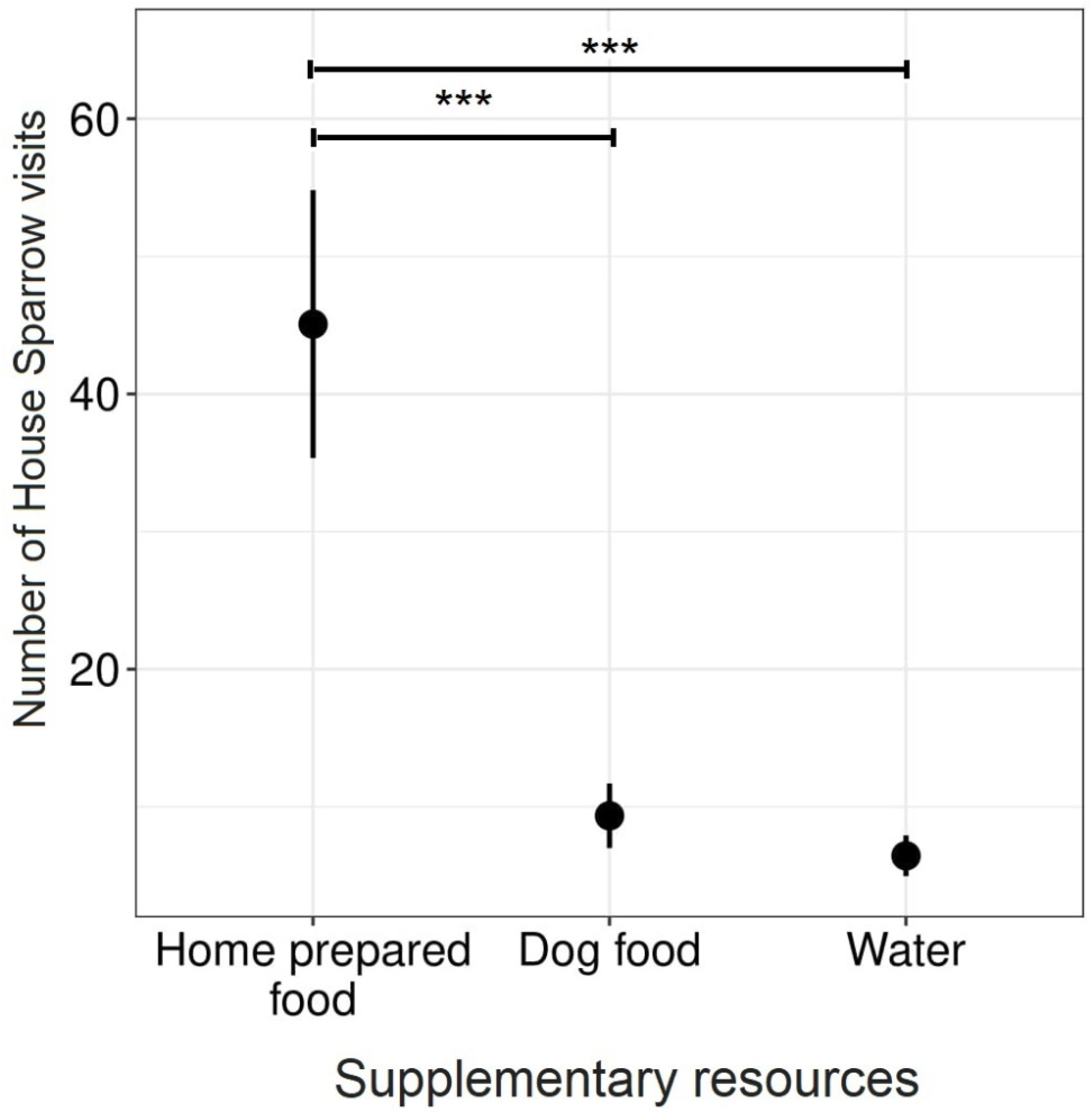Does Traditional Feeding of Outdoor Guard Dogs Provide a Food Resource for Wild Mammals and Birds?
Abstract
Simple Summary
Abstract
1. Introduction
2. Material and Methods
2.1. Fieldwork
2.2. Statistical Analysis
3. Results
4. Discussion
5. Conclusions
Author Contributions
Funding
Institutional Review Board Statement
Informed Consent Statement
Data Availability Statement
Acknowledgments
Conflicts of Interest
References
- Donald, P.F.; Green, R.E.; Heath, M.F. Agricultural intensification and the collapse of Europe’s farmland bird populations. Proc. R. Soc. Lond. B Biol. 2001, 268, 25–29. [Google Scholar] [CrossRef]
- Reif, J.; Vermouzek, Z. Collapse of farmland bird populations in an Eastern European country following its EU accession. Conserv. Lett. 2019, 12, e12585. [Google Scholar] [CrossRef]
- Rosin, Z.M.; Hiron, M.; Żmihorski, M.; Szymański, P.; Tobolka, M.; Pärt, T. Reduced biodiversity in modernized villages: A conflict between sustainable development goals. J. Appl. Ecol. 2020, 57, 467–475. [Google Scholar] [CrossRef]
- Tryjanowski, P.; Hartel, T.; Báldi, A.; Szymański, P.; Tobolka, M.; Herzon, I.; Goławski, A.; Konvička, M.; Hromada, M.; Jerzak, L.; et al. Conservation of farmland birds faces different challenges in Western and Central-Eastern Europe. Acta Ornithol. 2011, 46, 1–12. [Google Scholar] [CrossRef]
- Rosin, Z.M.; Skórka, P.; Pärt, T.; Żmihorski, M.; Ekner-Grzyb, A.; Kwieciński, Z.; Tryjanowski, P. Villages and their old farmsteads are hot spots of bird diversity in agricultural landscapes. J. Appl. Ecol. 2016, 53, 1363–1372. [Google Scholar] [CrossRef]
- Šálek, M.; Bažant, M.; Żmihorski, M. Active farmsteads are year-round strongholds for farmland birds. J. Appl. Ecol. 2018, 55, 1908–1918. [Google Scholar] [CrossRef]
- Šálek, M.; Havlíček, J.; Riegert, J.; Nešpor, M.; Fuchs, R.; Kipson, M. Winter density and habitat preferences of three declining granivorous farmland birds: The importance of the keeping of poultry and dairy farms. J. Nat. Conserv. 2015, 24, 10–16. [Google Scholar] [CrossRef]
- Goławski, A.; Dombrowski, A. The effects of weather conditions on the numbers of wintering birds and the diversity of their assemblages in villages and crop fields in east-central Poland. Ital. J. Zool. 2011, 78, 364–369. [Google Scholar] [CrossRef]
- Siriwardena, G.M.; Calbrade, N.A.; Vickery, J.A. Farmland birds and late winter food: Does seed supply fail to meet demand? IBIS 2008, 150, 585–595. [Google Scholar] [CrossRef]
- Tryjanowski, P.; Skórka, P.; Sparks, T.H.; Biaduń, W.; Brauze, T.; Hetmański, T.; Matryka, P.; Indykiewicz, P.; Myczko, Ł.; Kunysz, P.; et al. Urban and rural habitats differ in number and type of bird feeders and in bird species consuming supplementary food. Environ. Sci. Pollut. R. 2015, 22, 15097–15103. [Google Scholar] [CrossRef]
- Serpell, J. (Ed.) The Domestic Dog; Cambridge University Press: Cambridge, UK, 2016; ISBN 9781139161800. [Google Scholar] [CrossRef]
- Dodd, S.A.; Cave, N.J.; Adolphe, J.L.; Shoveller, A.K.; Verbrugghe, A. Plant-based (vegan) diets for pets: A survey of pet owner attitudes and feeding practices. PLoS ONE 2019, 14, e0210806. [Google Scholar] [CrossRef] [PubMed]
- Morelli, G.; Stefanutti, D.; Ricci, R.A. Survey among Dog and Cat Owners on Pet Food Storage and Preservation in the Households. Animals 2021, 11, 273. [Google Scholar] [CrossRef] [PubMed]
- Śleszyński, P.; Wiśniewski, R.; Szejgiec-Kolenda, B. Demographic processes in Poland in the years 1946–2016 and their consequences for local development: Current state and research perspectives. Geogr. Pol. 2018, 91, 317–334. [Google Scholar] [CrossRef]
- Okin, G.S. Environmental impacts of food consumption by dogs and cats. PLoS ONE 2017, 12, e0181301. [Google Scholar] [CrossRef] [PubMed]
- Trolliet, F.; Huynen, M.C.; Vermeulen, C.; Hambuckers, A. Use of camera traps for wildlife studies. A review. Biotechnol. Agron. Soc. 2014, 18, 446. [Google Scholar]
- Randler, C.; Kalb, N. Distance and size matters: A comparison of six wildlife camera traps and their usefulness for wild birds. Ecol. Evol. 2018, 8, 7151–7163. [Google Scholar] [CrossRef] [PubMed]
- Hole, D.G.; Whittingham, M.J.; Bradbury, R.B.; Anderson, G.Q.; Lee, P.L.; Wilson, J.D.; Krebs, J.R. Widespread local house-sparrow extinctions. Nature 2002, 418, 931. [Google Scholar] [CrossRef]
- Summers-Smith, J.D. The decline of the House Sparrow: A review. Brit. Birds 2003, 96, 439–446. [Google Scholar]
- Robinson, R.A.; Siriwardena, G.M.; Crick, H.Q. Size and trends of the House Sparrow Passer domesticus population in Great Britain. IBIS 2005, 147, 552–562. [Google Scholar] [CrossRef]
- Skórka, P.; Sierpowska, K.; Haidt, A.; Myczko, Ł.; Ekner-Grzyb, A.; Rosin, Z.M.; Kwiecinski, Z.; Suchodolska, J.; Takacs, V.; Jankowiak, Ł.; et al. Habitat preferences of two sparrow species are modified by abundances of other birds in an urban environment. Curr. Zool. 2016, 62, 357–368. [Google Scholar] [CrossRef]
- Cavalli, M.; Baladrón, A.V.; Isacch, J.P.; Biondi, L.M.; Bó, M.S. Differential risk perception of rural and urban Burrowing Owls exposed to humans and dogs. Behav. Process. 2016, 124, 60–65. [Google Scholar] [CrossRef] [PubMed]
- Vincze, E.; Papp, S.; Preiszner, B.; Seress, G.; Bókony, V.; Liker, A. Habituation to human disturbance is faster in urban than rural house sparrows. Behav. Ecol. 2016, 27, 1304–1313. [Google Scholar] [CrossRef]
- Gilmore, R.O.; Adolph, K.E. Video can make behavioural science more reproducible. Nat. Hum. Behav. 2017, 1, s41562-017. [Google Scholar] [CrossRef] [PubMed]
- R Core Team. R: A Language and Environment for Statistical Computing; R Foundation for Statistical Computing: Vienna, Austria, 2016. [Google Scholar] [CrossRef]
- Bates, D.; Maechler, M.; Bolker, B.; Walker, S. Fitting Linear Mixed-Effects Models Using lme4. J. Stat. Softw. 2015, 67, 1–48. [Google Scholar] [CrossRef]
- Wickham, H. ggplot2. WIRES Comput. Stat. 2011, 3, 180–185. [Google Scholar] [CrossRef]
- Lenth, R.V. Using lsmeans. J. Stat. Softw. 2017, 69, 1–33. [Google Scholar] [CrossRef]
- Krauze-Gryz, D.; Gryz, J.; Goszczyński, J. Predation by domestic cats in rural areas of central Poland: An assessment based on two methods. J. Zool. 2012, 288, 260–266. [Google Scholar] [CrossRef]
- Kosicki, J.Z.; Sparks, T.H.; Tryjanowski, P. House sparrows benefit from the conservation of white storks. Naturwissenschaften 2007, 94, 412–415. [Google Scholar] [CrossRef]
- Bengtson, S.A.; Eliasen, K.; Jacobsen, L.M.; Magnussen, E. Man-dependence of House Sparrows (Passer domesticus) in the Faroe Islands: Habitat patch characteristics as determinants of presence and numbers. In Dorete—Her Book: Being a Tribute to Dorete Bloch and to Faroese Nature; Faroe University Press: Tórshvan, Faroe Islands, 2010; ISBN 978-99918-65-30-0. [Google Scholar]
- Pinowska, B. The effect of energy and building resources of females on the production of House Sparrow (Passer domesticus (L.)) populations. Ekol. Pol. 1979, 27, 363–396. [Google Scholar]
- Chastel, O.; Lacroix, A.; Kersten, M. Pre-breeding energy requirements: Thyroid hormone, metabolism and the timing of reproduction in house sparrows Passer domesticus. J. Avian Biol. 2003, 34, 298–306. [Google Scholar] [CrossRef]
- Husby, A.; Saether, B.E.; Jensen, H.; Ringsby, T.H. Causes and consequences of adaptive seasonal sex ratio variation in house sparrows. J. Anim. Ecol. 2006, 75, 1128–1139. [Google Scholar] [CrossRef] [PubMed]
- Krystofkova, M.; Fousová, P.; Exnerová, A. Nestling diet of the Common Magpie (Pica pica) in urban and agricultural habitats. Ornis Fenn. 2011, 88, 138–146. [Google Scholar]
- Giovannini, S.; Pewsner, M.; Hüssy, D.; Hächler, H.; Degiorgis, M.P.R.; Hirschheydt, J.V.; Origgi, F.C. Epidemic of salmonellosis in passerine birds in Switzerland with spillover to domestic cats. Vet. Pathol. 2013, 50, 597–606. [Google Scholar] [CrossRef] [PubMed]
- Smith, O.M.; Snyder, W.E.; Owen, J.P. Are we overestimating risk of enteric pathogen spillover from wild birds to humans? Biol. Rev. 2020, 95, 652–679. [Google Scholar] [CrossRef] [PubMed]
- Theimer, T.C.; Clayton, A.C.; Martinez, A.; Peterson, D.L.; Bergman, D.L. Visitation rate and behavior of urban mesocarnivores differs in the presence of two common anthropogenic food sources. Urban Ecosyst. 2015, 18, 895–906. [Google Scholar] [CrossRef]
- Pinowska, B.; Chylinski, G.; Gondek, B. Studies on the transmitting of salmonellae by house sparrows (Passer domesticus L.) in the region of Zulawy. Pol. Ecol. Stud. 1976, 2, 113–121. [Google Scholar]
- Olson, P.; Sandstedt, K. Campylobacter in the dog: A clinical and experimental study. Vet. Rec. 1987, 121, 99–101. [Google Scholar] [CrossRef]
- Acke, E.; McGill, K.; Golden, O.; Jones, B.R.; Fanning, S.; Whyte, P. Prevalence of thermophilic Campylobacter species in household cats and dogs in Ireland. Vet. Rec. 2009, 164, 44–47. [Google Scholar] [CrossRef]
- Tryjanowski, P.; Nowakowski, J.J.; Indykiewicz, P.; Andrzejewska, M.; Śpica, D.; Sandecki, R.; Mitrus, C.; Goławski, A.; Dulisz, B.; Dziarska, J.; et al. Campylobacter in wintering great tits Parus major in Poland. Environ. Sci. Pollut. R. 2020, 27, 7570–7577. [Google Scholar] [CrossRef]
- Antrop, M. Landscape change and the urbanization process in Europe. Landsc. Urban Plan. 2004, 67, 9–26. [Google Scholar] [CrossRef]


| Species | Number of Visits | Frequency [%] of Feeding Visits | ||
|---|---|---|---|---|
| Total | without Feeding | with Feeding | ||
| House Sparrow Passer domesticus | 1584 | 51 | 1533 | 87.4 |
| Magpie Pica pica | 122 | 8 | 114 | 6.5 |
| Rodents | 66 | 2 | 64 | 3.6 |
| Tree Sparrow Passer montanus | 28 | 1 | 27 | 1.5 |
| Collared Dove Streptopelia decaocto | 5 | 0 | 5 | 0.3 |
| Great Tit Parus major | 5 | 0 | 5 | 0.3 |
| Red Fox Vulpes vulpes | 3 | 0 | 3 | 0.2 |
| Feral Pigeon Columba livia f. urbana | 2 | 0 | 2 | 0.1 |
| Jay Garrulus glandarius | 2 | 1 | 1 | 0.1 |
| Beech Marten Martes foina | 1 | 0 | 1 | 0.1 |
| 1818 | 63 | 1755 | 100.0 | |
| Category | Female | Male | χ2 | p |
|---|---|---|---|---|
| Home prepared food | 681 | 536 | 17.28 | <0.001 |
| Dog food | 134 | 66 | 23.12 | <0.001 |
| Water | 57 | 59 | 0.034 | 0.853 |
| Variables | Wald χ2 | df | p |
|---|---|---|---|
| Food type | 11.47 | 2 | 0.003 |
| Sex | 0.08 | 1 | 0.781 |
| Dog reaction | 2.38 | 1 | 0.123 |
| Food type × Sex | 0.91 | 2 | 0.634 |
| Food type × Dog reaction | 3.59 | 2 | 0.166 |
| Sex × Dog reaction | 0.06 | 1 | 0.812 |
Publisher’s Note: MDPI stays neutral with regard to jurisdictional claims in published maps and institutional affiliations. |
© 2021 by the authors. Licensee MDPI, Basel, Switzerland. This article is an open access article distributed under the terms and conditions of the Creative Commons Attribution (CC BY) license (https://creativecommons.org/licenses/by/4.0/).
Share and Cite
Andrzejczak, R.; Dylewski, Ł.; Jerzak, L.; Peťko, B.; Myczko, Ł. Does Traditional Feeding of Outdoor Guard Dogs Provide a Food Resource for Wild Mammals and Birds? Animals 2021, 11, 1198. https://doi.org/10.3390/ani11051198
Andrzejczak R, Dylewski Ł, Jerzak L, Peťko B, Myczko Ł. Does Traditional Feeding of Outdoor Guard Dogs Provide a Food Resource for Wild Mammals and Birds? Animals. 2021; 11(5):1198. https://doi.org/10.3390/ani11051198
Chicago/Turabian StyleAndrzejczak, Róża, Łukasz Dylewski, Leszek Jerzak, Branislav Peťko, and Łukasz Myczko. 2021. "Does Traditional Feeding of Outdoor Guard Dogs Provide a Food Resource for Wild Mammals and Birds?" Animals 11, no. 5: 1198. https://doi.org/10.3390/ani11051198
APA StyleAndrzejczak, R., Dylewski, Ł., Jerzak, L., Peťko, B., & Myczko, Ł. (2021). Does Traditional Feeding of Outdoor Guard Dogs Provide a Food Resource for Wild Mammals and Birds? Animals, 11(5), 1198. https://doi.org/10.3390/ani11051198





